美国人权法案-英文版
权利法案中英文版
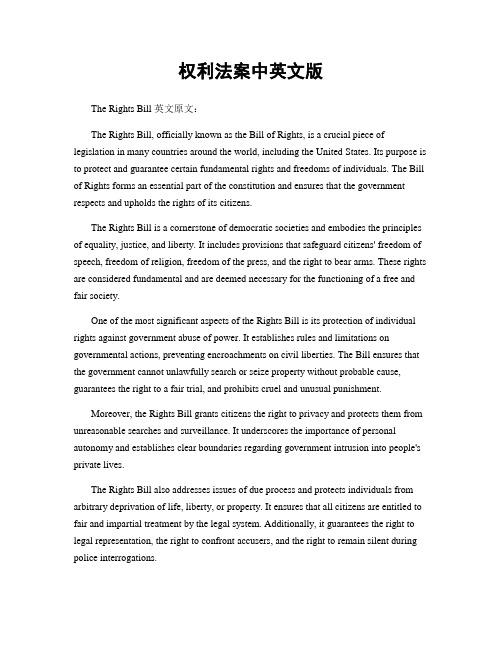
权利法案中英文版The Rights Bill 英文原文:The Rights Bill, officially known as the Bill of Rights, is a crucial piece of legislation in many countries around the world, including the United States. Its purpose is to protect and guarantee certain fundamental rights and freedoms of individuals. The Bill of Rights forms an essential part of the constitution and ensures that the government respects and upholds the rights of its citizens.The Rights Bill is a cornerstone of democratic societies and embodies the principles of equality, justice, and liberty. It includes provisions that safeguard citizens' freedom of speech, freedom of religion, freedom of the press, and the right to bear arms. These rights are considered fundamental and are deemed necessary for the functioning of a free and fair society.One of the most significant aspects of the Rights Bill is its protection of individual rights against government abuse of power. It establishes rules and limitations on governmental actions, preventing encroachments on civil liberties. The Bill ensures that the government cannot unlawfully search or seize property without probable cause, guarantees the right to a fair trial, and prohibits cruel and unusual punishment.Moreover, the Rights Bill grants citizens the right to privacy and protects them from unreasonable searches and surveillance. It underscores the importance of personal autonomy and establishes clear boundaries regarding government intrusion into people's private lives.The Rights Bill also addresses issues of due process and protects individuals from arbitrary deprivation of life, liberty, or property. It ensures that all citizens are entitled to fair and impartial treatment by the legal system. Additionally, it guarantees the right to legal representation, the right to confront accusers, and the right to remain silent during police interrogations.In addition to protecting individual rights, the Rights Bill also includes provisions regarding the rights of minority groups. It prohibits discrimination based on race, gender, religion, or sexual orientation. This ensures equal treatment and opportunities for all individuals within society.The Rights Bill is not without controversy. Some argue that certain rights guaranteed by the Bill of Rights may conflict with the greater good or national security. There are ongoing debates regarding the interpretation and application of these rights in specific situations. Balancing individual freedoms with collective interests remains a challenge for lawmakers and the judiciary.In conclusion, the Rights Bill plays a vital role in safeguarding the rights and freedoms of individuals in democratic societies. Its provisions protect citizens from government encroachment, ensure due process, and promote equality. The Bill of Rights symbolizes the commitment to a fair and just society, where every individual is entitled to basic human rights and liberties.。
美国权利法案原文
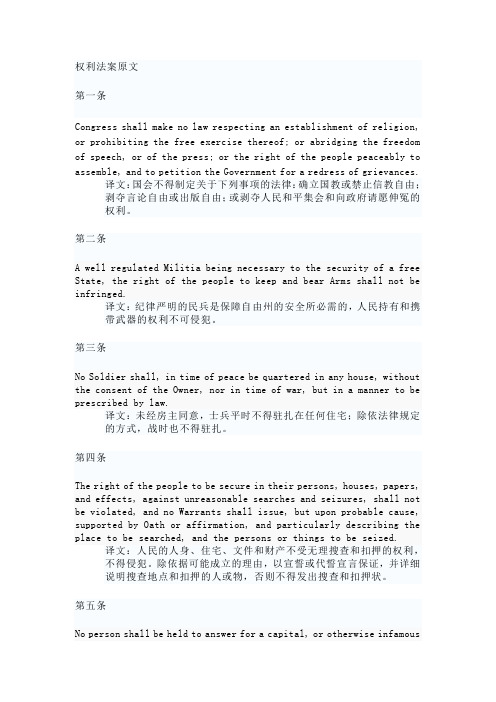
权利法案原文第一条Congress shall make no law respecting an establishment of religion, or prohibiting the free exercise thereof; or abridging the freedom of speech, or of the press; or the right of the people peaceably to assemble, and to petition the Government for a redress of grievances.译文:国会不得制定关于下列事项的法律:确立国教或禁止信教自由;剥夺言论自由或出版自由;或剥夺人民和平集会和向政府请愿伸冤的权利。
第二条A well regulated Militia being necessary to the security of a free State, the right of the people to keep and bear Arms shall not be infringed.译文:纪律严明的民兵是保障自由州的安全所必需的,人民持有和携带武器的权利不可侵犯。
第三条No Soldier shall, in time of peace be quartered in any house, without the consent of the Owner, nor in time of war, but in a manner to be prescribed by law.译文:未经房主同意,士兵平时不得驻扎在任何住宅;除依法律规定的方式,战时也不得驻扎。
第四条The right of the people to be secure in their persons, houses, papers, and effects, against unreasonable searches and seizures, shall not be violated, and no Warrants shall issue, but upon probable cause, supported by Oath or affirmation, and particularly describing the place to be searched, and the persons or things to be seized.译文:人民的人身、住宅、文件和财产不受无理搜查和扣押的权利,不得侵犯。
(完整版)美国侵权法(中英文)
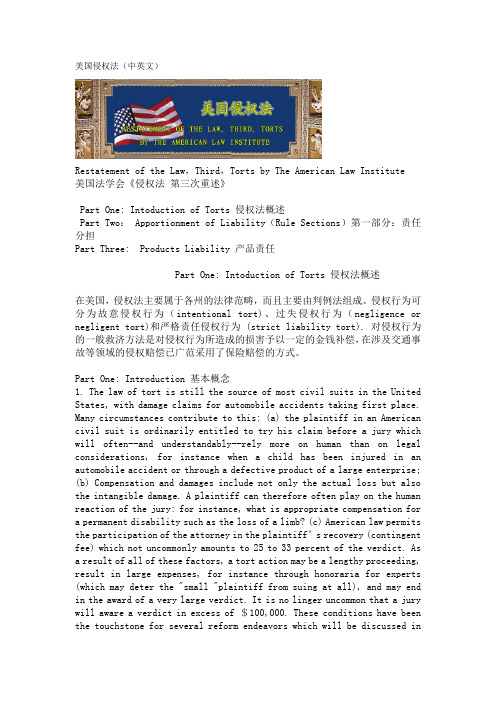
美国侵权法(中英文)Restatement of the Law,Third,Torts by The American Law Institute美国法学会《侵权法第三次重述》Part One: Intoduction of Torts 侵权法概述Part Two: Apportionment of Liability(Rule Sections)第一部分:责任分担Part Three: Products Liability 产品责任Part One: Intoduction of Torts 侵权法概述在美国,侵权法主要属于各州的法律范畴,而且主要由判例法组成。
侵权行为可分为故意侵权行为(intentional tort)、过失侵权行为(negligence or negligent tort)和严格责任侵权行为 (strict liability tort). 对侵权行为的一般救济方法是对侵权行为所造成的损害予以一定的金钱补偿,在涉及交通事故等领域的侵权赔偿已广范采用了保险赔偿的方式。
Part One: Introduction 基本概念1. The law of tort is still the source of most civil suits in the United States, with damage claims for automobile accidents taking first place. Many circumstances contribute to this: (a) the plaintiff in an American civil suit is ordinarily entitled to try his claim before a jury which will often--and understandably--rely more on human than on legal considerations, for instance when a child has been injured in an automobile accident or through a defective product of a large enterprise;(b) Compensation and damages include not only the actual loss but also the intangible damage. A plaintiff can therefore often play on the human reaction of the jury: for instance, what is appropriate compensation for a permanent disability such as the loss of a limb? (c) American law permits the participation of the attorney in the plaintiff’s recovery (contingent fee) which not uncommonly amounts to 25 to 33 percent of the verdict. As a result of all of these factors, a tort action may be a lengthy proceeding, result in large expenses, for instance through honoraria for experts (which may deter the "small "plaintiff from suing at all), and may end in the award of a very large verdict. It is no linger uncommon that a jury will aware a verdict in excess of $100,000. These conditions have been the touchstone for several reform endeavors which will be discussed inmore detail below.在美国,侵权行为法产生的诉讼仍是大多民事诉讼案件的主要来源,其中基于交通事故产生的损害赔偿案件居于首位。
国际人权法 外文版
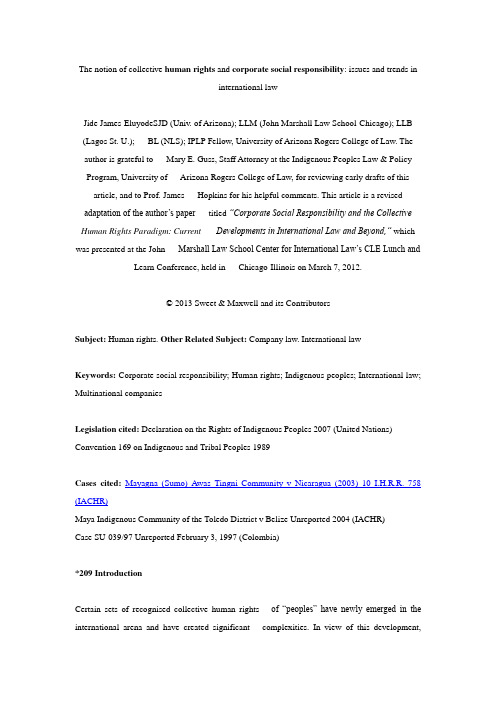
The notion of collective human rights and corporate social responsibility: issues and trends ininternational lawJide James-EluyodeSJD (Univ. of Arizona); LLM (John Marshall Law School-Chicago); LLB (Lagos St. U.); BL (NLS); IPLP Fellow, University of Arizona Rogers College of Law. The author is grateful to Mary E. Guss, Staff Attorney at the Indigenous Peoples Law & Policy Program, University of Arizona Rogers College of Law, for reviewing early drafts of this article, and to Prof. James Hopkins for his helpful comments. This article is a revised adaptation of the author’s paper titled “Corporate Social Responsibility and the Collective Human Rights Paradigm: Current Developments in International Law and Beyond,” which was presented at the John Marshall Law School Center for International Law’s CLE Lunch and Learn Conference, held in Chicago-Illinois on March 7, 2012.© 2013 Sweet & Maxwell and its ContributorsSubject: Human rights. Other Related Subject: Company law. International lawKeywords: Corporate social responsibility; Human rights; Indigenous peoples; International law; Multinational companiesLegislation cited: Declaration on the Rights of Indigenous Peoples 2007 (United Nations) Convention 169 on Indigenous and Tribal Peoples 1989Cases cited: Mayagna (Sumo) Awas Tingni Community v Nicaragua (2003) 10 I.H.R.R. 758 (IACHR)Maya Indigenous Community of the Toledo District v Belize Unreported 2004 (IACHR)Case SU-039/97 Unreported February 3, 1997 (Colombia)*209IntroductionCertain sets of recognised collective human rights of “peoples” have newly emerged in the international arena and have created significant complexities. In view of this development,corporations need to re-evaluate the question of their conduct and the nature of the responsibility they owe with respect to the human rights of groups or communities as collective units. This is so because traditional human rights were individual-based, but as that focus is shifting so must the standards for evaluating corporate conduct within host communities.This article examines some of the challenges that the newly evolved international normative standards regarding collective human rights of peoples, otherwise called “indigenous peoples’ rights”, present for corporations. This article reviews the changing expectation for corporate behaviour, and the implications on corporate operations, of some of the relevant international instruments and guiding frameworks on indigenous rights. These include the United Nations Declaration on Rights of Indigenous Peoples; ILO Convention 169; the World Bank Operational Policy on Indigenous Peoples; OECD Guidelines for Multinational Enterprises; the Akwé: Kon Guidelines; and the UN Protect, Respect and Remedy Framework for Business and Human Rights.This article finds that it has become imperative for corporations to be familiar with the new set of human rights of peoples and that failure to be proactive can be very costly. The article also counsels that owing to the unique nature of indigenous human rights, any compliance model adopted by corporate entities ought to reflect this unique quality, because simply adopting the generic human rights compliance model may prove to be ineffective.Collective human rights—how so?The concept of human rights has generally referred to composition of innate privileges which a person is entitled to enjoy simply because of his/her humanity.1 These rights are based on the principle that every person, irrespective of who he or she is and where he or she is, is the subject of rights and is entitled to all civil, political, economic, social and cultural rights.2 The idea of human rights has been recognised globally as the fundamental requirement for upholding human dignity, freedom, peace and justice in all societies.3Although the evolution of human rights can be traced as far back as medieval times,4the modern conception of internationally affirmed human rights arose in the 20th century. Countriesbanded together in the aftermath of brutal wars and atrocities to combat increasing infraction on liberty, freedom, dignity and worth of the human person, resulting in the establishment of the Uni ted Nations (“UN”) in 1945 and later, the adoption of the Universal Declaration of Human Rights (“UDHR”) by the UN General Assembly in 1948.5Historically, human rights were believed to have been conceived as rights enjoyed by individuals only.6As Thomas Aquinas puts it, natural law (which has been asserted as a foundational basis for the evolution of human rights),7 confers certain immutable rights upon individuals.8Others have justified their support for the notion of human rights adhering only to individuals by suggesting that most traditional human rights instruments only admit individuals as the principal beneficiaries of*210 rights proclaimed by such instruments.9 They add that the abstract concept of collective human rights too often presents great obstruction to the enjoyment by individuals of their human rights.10However, many, including the UN, have countered this notion by asserting that an insistence that human rights can only be held as individual rights will be, for all practical purpose, at variance with the social realities of human situations.11 They argued that conjoined rights, such as the rights of peoples or the rights of cultural minorities, are valid constituents of human rights.12Moreover, claims suggesting that most primary human rights instruments admit of only individual beneficiaries may be, in fact, erroneous. This is because art.1 of the UN Charter of 1945,13 as well as art.1 common to both the International Covenant on Civil and Political Rights (“ICCPR”) of 1966 and the International Covenant on Economic, Social and Cultural Rights (“ICESCR”) of 1966 contain provisions which protect and respect the princi ple of equal rights and right to self-determination of peoples.14 Additionally, the Committee on the Elimination of Racial Discrimination (“CERD”), a UN treaty monitoring body, once declared that protection of the right of indigenous peoples, as a collective unit, to be free from discrimination, falls under the scope of the International Convention on the Elimination of all forms of Racial Discrimination of 1965.15The Committee concluded that the Convention will apply to any discriminatory acts perpetrated against peoples.16In light of the above, the UN subsequently affirmed that, owing to the peculiar circumstances of some demographics within society, the disproportionate discrimination they suffered, and in linewith the fundamental human rights principles of universality, equality and non-discrimination, the equal worth and dignity of peoples can only be best assured through the recognition and protection not only of their individual human rights but also of their collective rights as distinct groups.17The socially responsible businessThe need for some form of socially conscious behaviour on the part of businesses is not a completely new idea18; the question of what extent of social interaction and degree of social responsibility that private corporate entities owe their employees, customers and neighbours (the society at large), has been consistently debated since the early 20th century.19 Conceptual elements of what constitutes responsible corporate behaviour have always evolved with times.20Thus, over the years, corporate social responsibility (“CSR”) has mirrored different eras of social awareness, progressively evolving from dealing with employment, labour, environmental, and human rights conscious concepts.21There seems to be no singular and universally applicable definition of CSR. Nevertheless, one may characterise the social responsibility of corporations as their commitments to contribute to sustainable socio-economic development of the local community in which they operate, in ways that are both good for the bottom line of the business and for societal development.22The essence of CSR inc ludes a corporation’s legal and social obligations to the societies in which it operates, coupled with how the corporation accounts to the host community for those obligations.23For instance, Archie Carroll has proposed that the key responsibility of a corporation is to generate profits for the shareholders, and to do so within the legal framework drawn by the host government.24Subsidiary to the economic and legal responsibilities is a corporation’s ethical responsibility to conduct its business in accordance with acceptable standards and avoid detriment to its stakeholders. At the*211end is the corporation’s responsibility to adopt a philanthropic (discretionary) strategy that can be beneficial to the business and then to society.25The assertion that profit is the principal basis of any business enterprise, and that only profitable companies are capable of creating goods/services and ultimately adding value to the society, may still be valid.26Notwithstanding, the condition of our modern society now suggests that long-term profitability, as well as the sustainability of a corporation’s business operations, cannot reasonably be detached from the quality of the social licence conferred by a host community as stakeholder in the socio-economic structure.27In other words, the pursuit of profit and respect for human rights of host communities or good corporate citizenship are not two mutually opposing objectives. As John Kamm stated28 :“While it might not always be the case that trade and businesses are good for human rights, it most certainly is the case that a good human rights environment is always good for business. Businesses are acting in their own self-interest when they actively promote respect for human rights in countries where they operate. 29In the last decade, mechanisms of international human rights institutions have devoted an increasing level of attention to the issue of social responsibilities of businesses, especially in relation to the collective rights of inhabitants living within a host community. For instance, in 2001 the UN Commission on Human Rights (now Human Rights Council) appointed a Special Rapporteur on the Situation of Human Rights and Fundamental Freedoms of Indigenous Peoples as part of its Special Procedures.30 The Special Rapporteur in discharging the mandate of the Human Rights Council has committed significant amounts of time to the issue of CSR and collective rights. In 2010, a thematic report outlining the responsibility of corporations with respect to indigenous rights was published.31 In 2011 a more specific report dealt with the corporate responsibility of businesses operating in the extractive sector.32Likewise, in 2005 the UN Secretary-General appointed a Special Representative on the Issue of Human Rights and Transnational Corporations and other Business Enterprises.33 The mandate of the Special Representative mainly concerns the identification and clarification of standards of corporate responsibility and accountability with regard to general human rights standards. But owing to the currency of the issue, the Special Representative devoted some time as well to expounding on the role of corporations in relation to the human rights of indigenous peoples.34。
美国1964年民权法案
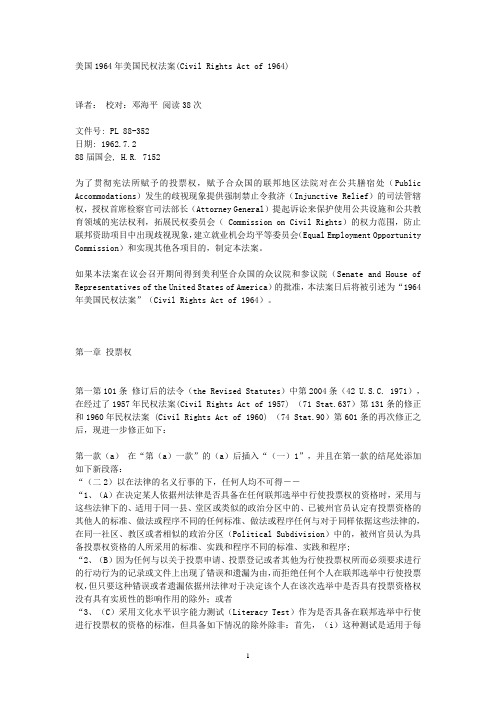
美国1964年美国民权法案(Civil Rights Act of 1964)译者:校对:邓海平阅读38次文件号: PL 88-352日期: 1962.7.288届国会, H.R. 7152为了贯彻宪法所赋予的投票权,赋予合众国的联邦地区法院对在公共膳宿处(Public Accommodations)发生的歧视现象提供强制禁止令救济(Injunctive Relief)的司法管辖权,授权首席检察官司法部长(Attorney General)提起诉讼来保护使用公共设施和公共教育领域的宪法权利,拓展民权委员会( Commission on Civil Rights)的权力范围,防止联邦资助项目中出现歧视现象,建立就业机会均平等委员会(Equal Employment Opportunity Commission)和实现其他各项目的,制定本法案。
如果本法案在议会召开期间得到美利坚合众国的众议院和参议院(Senate and House of Representatives of the United States of America)的批准,本法案日后将被引述为“1964年美国民权法案”(Civil Rights Act of 1964)。
第一章投票权第一第101条修订后的法令(the Revised Statutes)中第2004条(42 U.S.C. 1971),在经过了1957年民权法案(Civil Rights Act of 1957) (71 Stat.637)第131条的修正和1960年民权法案 (Civil Rights Act of 1960) (74 Stat.90)第601条的再次修正之后,现进一步修正如下:第一款(a)在“第(a)一款”的(a)后插入“(一)1”,并且在第一款的结尾处添加如下新段落:“(二2)以在法律的名义行事的下,任何人均不可得――“1、(A)在决定某人依据州法律是否具备在任何联邦选举中行使投票权的资格时,采用与这些法律下的、适用于同一县、堂区或类似的政治分区中的、已被州官员认定有投票资格的其他人的标准、做法或程序不同的任何标准、做法或程序任何与对于同样依据这些法律的,在同一社区、教区或者相似的政治分区(Political Subdivision)中的,被州官员认为具备投票权资格的人所采用的标准、实践和程序不同的标准、实践和程序;“2、(B)因为任何与以关于投票申请、投票登记或者其他为行使投票权所而必须要求进行的行动行为的记录或文件上出现了错误和遗漏为由,而拒绝任何个人在联邦选举中行使投票权,但只要这种错误或者遗漏依据州法律对于决定该个人在该次选举中是否具有投票资格权没有具有实质性的影响作用的除外;或者“3、(C)采用文化水平识字能力测试(Literacy Test)作为是否具备在联邦选举中行使进行投票权的资格的标准,但具备如下情况的除外除非:首先,(i)这种测试是适用于每个个人,并且是完全通过书面的方式进行的;其次,而且(ii)当受试者在1960年民权法案(Civil Rights Act of 1960)(42 U.S.C. 1974—74e; 74 Stat.88)第III条规定的记录和文件的保留期内提出请求时,在该受试者提出请求的25天之内,向该受试者提供该次测试的经核对无误的该测试经过验证的试题和该个人受试者的答案的副本,将会在这些记录和文件依据1960年民权法案(Civil Rights Act of 1960)(42 U.S.C. 1974—74e; 74 Stat.88)第三章所规定的保留和保存期内,应受试者的要求而在他提出要求的25日内向他提供;但首席检察官司法部长司法部长(Attorney General)可以和适当相关的州或者地方权力机关(Local Authorities)达成协议,认定依据相关州法律或地方法律中的条文——包括在为盲人或者有其他身体残疾的人就准备、实施和维持该种测试时所必须制定的特殊条文在内——准备、实施和维持的此种测试所应适用的该州或地方法律的相关条文达成一致,这些条文包括那些盲人或者其他的残疾人接受测试必要的特别规定,则上述的准备、实施和维持行为是符合本小段的目的意图且符合并且应视为对本小段的规定规定的遵守。
权利法案的简介及影响
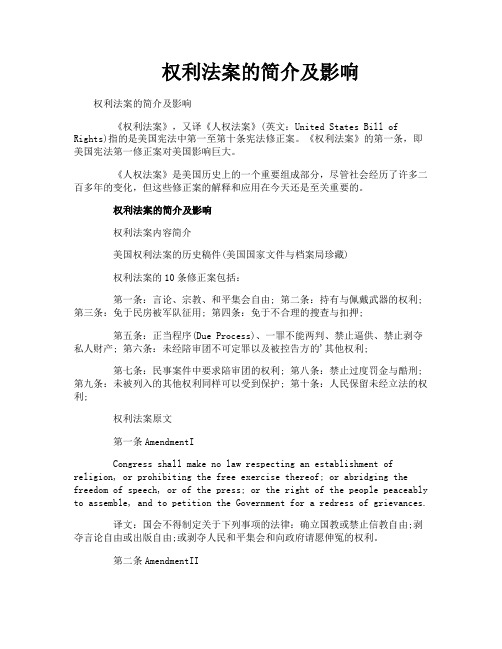
权利法案的简介及影响权利法案的简介及影响《权利法案》,又译《人权法案》(英文:United States Bill of Rights)指的是美国宪法中第一至第十条宪法修正案。
《权利法案》的第一条,即美国宪法第一修正案对美国影响巨大。
《人权法案》是美国历史上的一个重要组成部分,尽管社会经历了许多二百多年的变化,但这些修正案的解释和应用在今天还是至关重要的。
权利法案的简介及影响权利法案内容简介美国权利法案的历史稿件(美国国家文件与档案局珍藏)权利法案的10条修正案包括:第一条:言论、宗教、和平集会自由; 第二条:持有与佩戴武器的权利; 第三条:免于民房被军队征用; 第四条:免于不合理的搜查与扣押;第五条:正当程序(Due Process)、一罪不能两判、禁止逼供、禁止剥夺私人财产; 第六条:未经陪审团不可定罪以及被控告方的'其他权利;第七条:民事案件中要求陪审团的权利; 第八条:禁止过度罚金与酷刑; 第九条:未被列入的其他权利同样可以受到保护; 第十条:人民保留未经立法的权利;权利法案原文第一条AmendmentICongress shall make no law respecting an establishment of religion, or prohibiting the free exercise thereof; or abridging the freedom of speech, or of the press; or the right of the people peaceably to assemble, and to petition the Government for a redress of grievances.译文:国会不得制定关于下列事项的法律:确立国教或禁止信教自由;剥夺言论自由或出版自由;或剥夺人民和平集会和向政府请愿伸冤的权利。
第二条AmendmentIIA well regulated Militia being necessary to the security of a free State, the right of the people to keep and bear Arms shall not be infringed.译文:纪律严明的民兵是保障自由州的安全所必需的,人民持有和携带武器的权利不可侵犯。
英文介绍美国的三权分立制度

The separation of power and the system of checks-and—balances in USAIt is known to us that the political system vary from country to country depending on its different national condition,such as the constitutional monarchy of UK and the People's Congress system of China, the separation of power of US。
During this discussion,we will talk about the how the American government works under the idea of separation of power which is associated with the checks and balances system。
According to the U.S。
Constitution declared that the government was divided into three different branches including a legislative, an executive and a judiciary,in accordance with the idea of separation of power. This idea was created because that Americans did not want these powers to be controlled by just one man or one group。
They were afraid that if a small group received too much power,the United States would wind up under the rule of another dictator or tyrant。
美国黑人人权运动(英语版)

Event process
• Exercise is the peak in 1963 in August, dr. King of the Lincoln memorial in Washington before square gathered 250,000 masses, and published his famous speech "I have a dream", the gathering produced by the pressure of public opinion, and finally force congress passed the Civil Rights Act in the following, announced that racial segregation and discriminatory policies for the American civil rights movement of illegal, become the key events.
African-American Civil Rights Movement
Producer :0236 Tang Ling
Event introduction
1955—1968,The second world war in American blacks oppose racial segregation and discrimination,part of the civil rights movement. In the 1950‘s rise, until the 1970s. But through non-violent protests, strive for African American people's right of mass struggle.
the Bill of Rights 美国权利法案

Feel Free to SayThere is a famous quote said by Voltaire, “I disapprove of what you say, but I will defend to the death your right to say it.” These are the best words to impress on us how important the freedom of speech and press is. Historically, it is hard to ignore the far-reaching implications for the U.S. created by Amendment I from the Bill of Rights.The great law is to protect the right of every single identity including individuals and organizations to express his or its ideas by any unharmful action, not only the words. For example, there was a case that three children prosecuted their school for punishing their wearing black veils in order to be against the Vietnam War in 1965. In the end, the court also used Amendment I from the Bill of Rights to explain these children’s actions were legal. It was famous because it showed everyone has the right given by the Bill of Rights to express their ways more than words. What’s more, why does Amendment I from the Bill of Rights make us live better?The point is it protects opportunities to voice different opinions or ideas, which limits any power around us and provide unlimited resources to improve the society. It should have far-reaching implications because it is the basic human right for everyone.Amendment I from the Bill of Rights is a great law that makes our society beautiful. As those great legislators did two hundred years ago, every great judge will use it to finish his mission to protect people, and it will prevent the U.S. people from any violation of freedom behaviors in the future.。
美国黑人人权运动英语课件
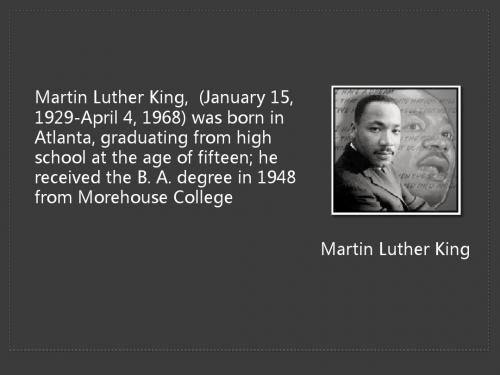
The End
On the evening of April 4, 1968, while standing on the balcony of his motel room in Memphis, Tennessee, where he was to lead a protest march in sympathy with striking garbage workers of that city, he was assassinated.
He directed the peaceful march on Washington, D.C., of 250,000 people to whom he delivered his address, "l Have a Dream", he conferred with President John F. Kennedy and campaigned for President Lyndon B. Johnson.He was awarded five honorary degrees and became not only the symbolic leader of American blacks but also a world figure.
Martin Luther King, (January 15, 1929-April 4, 1968) was born in Atlanta, graduating from high school at the age of fifteen; he received the B. A. degree in 1948 from Morehouse College Martin Luther King
美国联邦宪法案例—论公民的言论自由权

TINKER ET AL. v. DES MOINES美国最高法院393 US 5031969年2月24日决定案情1965年12月,得梅因中学,爱荷华州的居民约翰(15岁)、约翰的妹妹玛丽(13岁),以及他们的朋友克里斯托弗(16岁)决定穿着有和平象征意义的黑色臂章去学校(约翰和克里斯托弗为中学,玛丽为中学),以抗议越南战争并支持参议员罗伯特肯尼迪所称的圣诞节休战。
得梅因中学的校长采取了一项措施,禁止学生戴袖章上学。
违反的学生将被暂停学业直到他们同意遵守此措施才准许返回学校。
玛丽和克里斯托弗选择了违反此措施,次日约翰也这样做了。
当他们的抗议计划结束后学校的处罚在1966年1月1日暂停。
在爱荷华州公民自由联盟走进他们家庭并且美国公民自由联盟同意帮助提起诉讼后他们才提起诉讼。
他们的父母向美国地方法院提起诉讼,而该法院维持了得梅因学校的决定。
在美国法院上诉8次而票数相等意味着地区法院的裁定继续成立,这迫使玛丽和克里斯托弗直接向美国最高法院提起上诉。
该案件直到1968年11月12日才在法庭上讨论。
判决意见福塔斯法官宣读了法院的意见。
申诉人约翰15岁,申诉人克里斯托弗16岁在爱荷华州得梅因高中学习。
申诉人玛丽13岁,她是约翰的妹妹,在一个初中学校学习。
在1965年12月,一群成年人和得梅因中学的学生在埃克哈特家举行了一个会议。
他们宣传反对敌视越南,并且通过节日期间穿着黑色臂章和在12月16日及除夕夜的禁食行动来支持停战。
请愿者和他们的父母曾经从事类似活动,他们决定参加该计划。
得梅因中学的校长知道了他们戴臂章的计划。
1965年12月14日他们开会通过了一项政策,那就是任何戴臂章去学校的学生必须摘掉臂章,否则他们将被暂停学业。
请愿者知道了学校领导采取的措施。
12月16日玛丽和克里斯托弗着黑色臂章去学校,次日约翰也穿着臂章。
他们被遣返回家并被暂停学业,直到不穿着臂章时。
他们直到穿着臂章计划终止也就是元旦才回到学校。
权利法案中英文版

权利法案(Bill of Rights)通常指的是特定国家的法律文件,它旨在保障公民的基本自由和权利不受政府侵犯。
以下是英国和美国各自的权利法案中英文对照概述:英国《权利法案》(1689年)中文标题:国民权利与自由和王位继承宣言英文全称:An Act Declaring the Rights and Liberties of the Subject and Settling the Succession of the Crown内容摘要:确立了议会至上的原则,限制国王的权力。
保障了宗教自由、言论自由和请愿权等基本权利。
规定国王必须定期召开议会,并且未经议会同意不得征税或维持常备军。
美国《权利法案》(1791年)英文名称:The Bill of Rights内容摘要:1. 第一条修正案:保障信仰、言论、出版、集会、请愿的自由。
2. 第二条修正案:保障人民持有并携带武器的权利。
3. 第三条修正案:禁止在和平时期无住宅主人同意的情况下驻扎士兵。
4. 第四条修正案:禁止非法搜查和扣押,除非有合理的理由和搜查令。
5. 第五条修正案:保障正当程序,包括不经合法程序不得剥夺生命、自由或财产;禁止双重危险及强迫自证其罪。
6. 第六条修正案:规定刑事审判中的各项权利,如迅速公开审判、由犯罪行为发生地的州和区公正陪审团审判、被告知指控详情、面对证人和获取律师帮助的权利等。
7. 第七条修正案:民事诉讼中,当案件涉及金额超过一定数额时,享有由陪审团审判的权利。
8. 第八条修正案:禁止施加过重的保释金、罚款以及残酷和非常规的惩罚。
9. 第九条修正案:保留未明确列举于宪法但属于人民的权利。
10. 第十条修正案:保留给各州或人民的那些未被宪法授予联邦政府、也未禁止各州行使的所有权力。
以上为简要概括,具体条款内容需查阅相关法律文本以获得详尽信息。
美国1964年民权法-英语行业-法律英语-
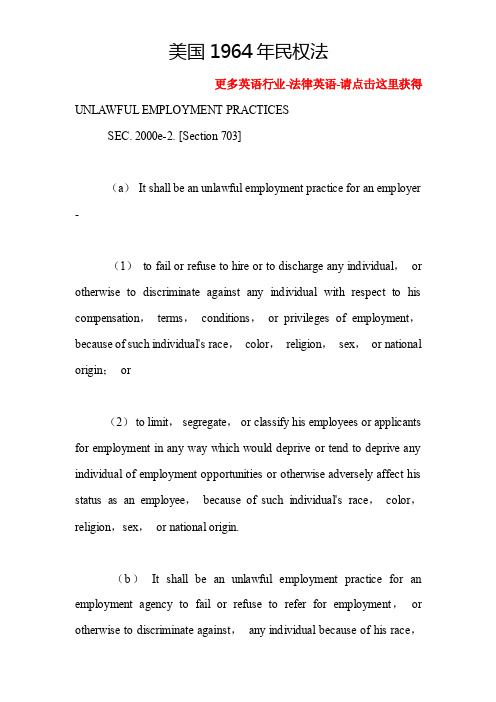
美国1964年民权法更多英语行业-法律英语-请点击这里获得UNLAWFUL EMPLOYMENT PRACTICESSEC. 2000e-2. [Section 703](a)It shall be an unlawful employment practice for an employer -(1)to fail or refuse to hire or to discharge any individual,or otherwise to discriminate against any individual with respect to his compensation,terms,conditions,or privileges of employment,because of such individual's race,color,religion,sex,or national origin;or(2)to limit,segregate,or classify his employees or applicants for employment in any way which would deprive or tend to deprive any individual of employment opportunities or otherwise adversely affect his status as an employee,because of such individual's race,color,religion,sex,or national origin.(b)It shall be an unlawful employment practice for an employment agency to fail or refuse to refer for employment,or otherwise to discriminate against,any individual because of his race,color,religion,sex,or national origin,or to classify or refer for employment any individual on the basis of his race,color,religion,sex,or national origin.(c)It shall be an unlawful employment practice for a labor organization-(1)to exclude or to expel from its membership,or otherwise to discriminate against,any individual because of his race,color,religion,sex,or national origin;(2)to limit,segregate,or classify its membership or applicants for membership,or to classify or fail or refuse to refer for employment any individual,in any way which would deprive or tend to deprive any individual of employment opportunities,or would limit such employment opportunities or otherwise adversely affect his status as an employee or as an applicant for employment,because of such individual's race,color,religion,sex,or national origin;or(3)to cause or attempt to cause an employer to discriminate against an individual in violation of this section.(d)It shall be an unlawful employment practice for anyemployer,labor organization,or joint labor-management committee controlling apprenticeship or other training or retraining,including on-the-job training programs to discriminate against any individual because of his race,color,religion,sex,or national origin in admission to,or employment in,any program established to provide apprenticeship or other training.(e)Notwithstanding any other provision of this subchapter,(1)it shall not be an unlawful employment practice for an employer to hire and employ employees,for an employment agency to classify,or refer for employment any individual,for a labor organization to classify its membership or to classify or refer for employment any individual,or for an employer,labor organization,or joint labor-management committee controlling apprenticeship or other training or retraining programs to admit or employ any individual in any such program,on the basis of his religion,sex,or national origin in those certain instances where religion,sex,or national origin is a bona fide occupational qualification reasonably necessary to the normal operation of that particular business or enterprise,and (2)it shall not be an unlawful employment practice for a school,college,university,or other educational institution or institution of learning to hire and employ employees of a particular religion if such school,college,university,or other educational institution or institution of learning is,in whole or in substantial part,owned,supported,controlled,or managed by a particular religion or by a particular religious corporation,association,or society,or if the curriculum of such school,college,university,or other educational institution or institution of learning is directed toward the propagation of a particular religion.(f)As used in this subchapter,the phrase ``unlawful employment practice'' shall not be deemed to include any action or measure taken by an employer,labor organization,joint labor-management committee,or employment agency with respect to an individual who is a member of the Communist Party of the United States or of any other organization required to register as a Communist-action or Communist-front organization by final order of the Subversive Activities Control Board pursuant to the Subversive Activities Control Act of 1950 [50 U.S.C. 781 et seq.].(g)Notwithstanding any other provision of this subchapter,it shall not be an unlawful employment practice for an employer to fail or refuse to hire and employ any individual for any position,for an employer to discharge any individual from any position,or for an employment agency to fail or refuse to refer any individual for employment in any position,or for a labor organization to fail or refuse to refer any individual for employment in any position,if-(1)the occupancy of such position,or access to the premises in or upon which any part of the duties of such position is performed or is to be performed,is subject to any requirement imposed in the interest of the national security of the United States under any security program in effect pursuant to or administered under any statute of the United States or any Executive order of the President;and(2)such individual has not fulfilled or has ceased to fulfill that requirement.(h)Notwithstanding any other provision of this subchapter,it shall not be an unlawful employment practice for an employer to apply different standards of compensation,or different terms,conditions,or privileges of employment pursuant to a bona fide seniority or merit system,or a system which measures earnings by quantity or quality of production or to employees who work in different locations,provided that such differences are not the result of an intention to discriminate because of race,color,religion,sex,or national origin,nor shall it be an unlawful employment practice for an employer to give and to act upon the results of any professionally developed ability test provided that such test,its administration or action upon the results is not designed,intended or used to discriminate because of race,color,religion,sexor national origin. It shall not be an unlawful employment practice under this subchapter for any employer to differentiate upon the basis of sex in determining the amount of the wages or compensation paid or to be paid to employees of such employer if such differentiation is authorized by the provisions of section 206(d)of title 29 [section 6(d)of the Fair Labor Standards Act of 1938,as amended].(i)Nothing contained in this subchapter shall apply to any business or enterprise on or near an Indian reservation with respect to any publicly announced employment practice of such business or enterprise under which a preferential treatment is given to any individual because he is an Indian living on or near a reservation.(j)Nothing contained in this subchapter shall be interpreted to require any employer,employment agency,labor organization,or joint labor-management committee subject to this subchapter to grant preferential treatment to any individual or to any group because of the race,color,religion,sex,or national origin of such individual or group on account of an imbalance which may exist with respect to the total number or percentage of persons of any race,color,religion,sex,or national origin employed by any employer,referred or classified for employment by any employment agency or labor organization,admitted to membership or classified by any labororganization,or admitted to,or employed in,any apprenticeship or other training program,in comparison with the total number or percentage of persons of such race,color,religion,sex,or national origin in any community,State,section,or other area,or in the available work force in any community,State,section,or other area.(k)(1)(A)An unlawful employment practice based on disparate impact is established under this title only if-(i) a complaining party demonstrates that a respondent uses a particular employment practice that causes a disparate impact on the basis of race,color,religion,sex,or national origin and the respondent fails to demonstrate that the challenged practice is job related for the position in question and consistent with business necessity;or(ii)the complaining party makes the demonstration described in subparagraph (C)with respect to an alternative employment practice and the respondent refuses to adopt such alternative employment practice.(B)(i)With respect to demonstrating that a particular employment practice causes a disparate impact as described in subparagraph (A)(i),the complaining party shall demonstrate that each particular challenged employment practice causes a disparate impact,except that if the complaining party can demonstrate to the court that the elements of a respondent's decisionmaking process are not capable of separation for analysis,the decisionmaking process may be analyzed as one employment practice.(ii)If the respondent demonstrates that a specific employment practice does not cause the disparate impact,the respondent shall not be required to demonstrate that such practice is required by business necessity.(C)The demonstration referred to by subparagraph (A)(ii)shall be in accordance with the law as it existed on June 4,1989,with respect to the concept of ``alternative employment practice''.(2)A demonstration that an employment practice is required by business necessity may not be used as a defense against a claim of intentional discrimination under this title.(3)Notwithstanding any other provision of this title, a rule barring the employment of an individual who currently and knowingly uses or possesses a controlled substance,as defined in schedules I and II of section 102(6)of the Controlled Substances Act (21 U.S.C. 802(6)),other than the use or possession of a drug taken under thesupervision of a licensed health care professional,or any other use or possession authorized by the Controlled Substances Act [21 U.S.C. 801 et seq.] or any other provision of Federal law,shall be considered an unlawful employment practice under this title only if such rule is adopted or applied with an intent to discriminate because of race,color,religion,sex,or national origin.(l)It shall be an unlawful employment practice for a respondent,in connection with the selection or referral of applicants or candidates for employment or promotion,to adjust the scores of,use different cutoff scores for,or otherwise alter the results of,employment related tests on the basis of race,color,religion,sex,or national origin.(m)Except as otherwise provided in this title,an unlawful employment practice is established when the complaining party demonstrates that race,color,religion,sex,or national origin was a motivating factor for any employment practice,even though other factors also motivated the practice.(n)(1)(A)Notwithstanding any other provision of law,and except as provided in paragraph (2),an employment practice that implements and is within the scope of a litigated or consent judgment or order that resolves a claim of employment discrimination under theConstitution or Federal civil rights laws may not be challenged under the circumstances described in subparagraph (B)。
Civil Liberties的课文及翻译

Civil Liberties的课文及翻译在1788年批准的宪法中包含了一些保障个人权利和自由的规定。
例如,第一条,第九章,除了在叛乱或受到侵犯的案件中,禁止人身保护令暂停;第一条第九和第十款,禁止州或联邦政府通过剥夺公民权或实际上事后通过的法律草案。
第三条第二款,保证由陪审团判刑事案件,除了弹劾案;第三条第三款,特别列举了叛国罪定罪的要求;第六条第二款,禁止宗教考试作为公职资格使用。
The Constitution, as ratified in 1788, contains a few provisions guaranteeing individual rights and liberties. For example, Article I, Section 9 prohibits the suspension of the writ of habeas corpus except in cases of rebellion or invasion; Article I, Sections 9 and 10 prohibit either the state or federal government from passing bills of attainder or ex post facto laws. Article III, Section 2 guarantees trial by jury in criminal cases except in cases of impeachment; Article III, Section 3 specifically enumerates the requirements for a conviction of treason, and Article VI, Section 2 prohibits the use of religious test as a qualification for public office.联邦权力结构可以作为额外保障个人权利和自由的力量。
平等权利法案
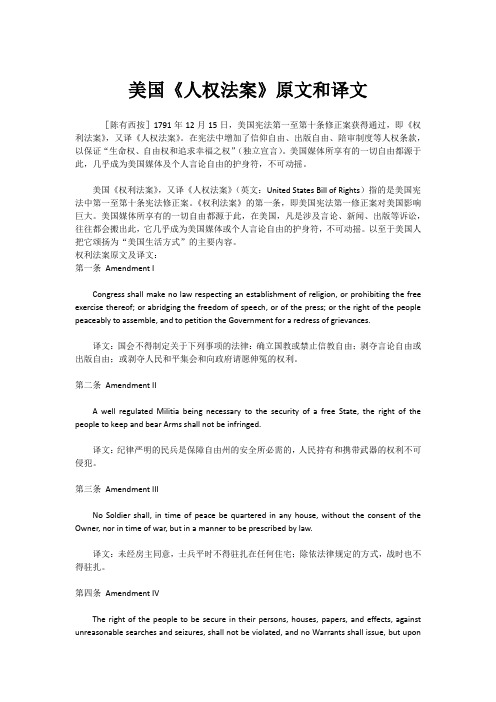
美国《人权法案》原文和译文[陈有西按]1791年12月15日,美国宪法第一至第十条修正案获得通过,即《权利法案》,又译《人权法案》。
在宪法中增加了信仰自由、出版自由、陪审制度等人权条款,以保证“生命权、自由权和追求幸福之权”(独立宣言)。
美国媒体所享有的一切自由都源于此,几乎成为美国媒体及个人言论自由的护身符,不可动摇。
美国《权利法案》,又译《人权法案》(英文:United States Bill of Rights)指的是美国宪法中第一至第十条宪法修正案。
《权利法案》的第一条,即美国宪法第一修正案对美国影响巨大。
美国媒体所享有的一切自由都源于此,在美国,凡是涉及言论、新闻、出版等诉讼,往往都会搬出此,它几乎成为美国媒体或个人言论自由的护身符,不可动摇。
以至于美国人把它颂扬为“美国生活方式”的主要内容。
权利法案原文及译文:第一条Amendment ICongress shall make no law respecting an establishment of religion, or prohibiting the free exercise thereof; or abridging the freedom of speech, or of the press; or the right of the people peaceably to assemble, and to petition the Government for a redress of grievances.译文:国会不得制定关于下列事项的法律:确立国教或禁止信教自由;剥夺言论自由或出版自由;或剥夺人民和平集会和向政府请愿伸冤的权利。
第二条Amendment IIA well regulated Militia being necessary to the security of a free State, the right of the people to keep and bear Arms shall not be infringed.译文:纪律严明的民兵是保障自由州的安全所必需的,人民持有和携带武器的权利不可侵犯。
权利法案(美国)-the Bill of Rights(中英文)

权利法案(美国)(中英文)1787年在费城起草的宪法,在各州审议批准的过程中,也有不少美国公民感到不安,因为宪法中并没有明确保障个人的权利。
因此,《宪法》补充了10条修正案,统一称为《权利法案》,英文叫The Bill of Rights。
由于补充了《权利法案》,《宪法》在13个州均获批准,并于1789年生效。
(左下图:美国威廉姆斯堡总督府的一个小会议室,就是《弗吉尼亚州权利法案》-后来成为美国宪法中《权利法案》蓝本的制定地) 第一条 Amendment II . F reedom of Speech, Press, Religion and Petition Congress shall make no law respecting an establishment of religion, or prohibiting the free exercise thereof; or abridging the freedom of speech, or of the press; or the right of the people peaceably to assemble, and to petition the Government for a redress of grievances. 译文:国会不得制定关于下列事项的法律:确立国教或禁止信教自由;剥夺言论自由或出版自由;或剥夺人民和平集会和向政府请愿伸冤的权利。
第二条 Amendment IIII . Right to keep and bear arms A well regulated Militia, being necessary to the security of a free State, the right of the people to keep and bear Arms, shall not be infringed. 译文:纪律严明的民兵是保障自由州的安全所必需的,人民持有和携带武器的权利不可侵犯。
美国人权法案(中英文对照)
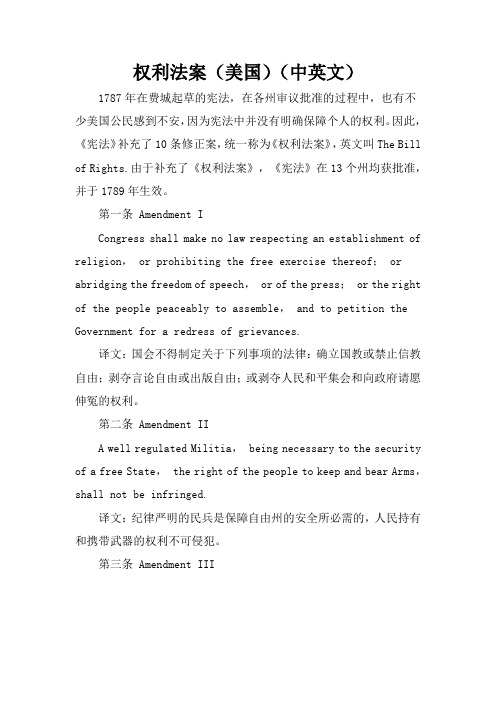
权利法案(美国)(中英文)1787年在费城起草的宪法,在各州审议批准的过程中,也有不少美国公民感到不安,因为宪法中并没有明确保障个人的权利。
因此,《宪法》补充了10条修正案,统一称为《权利法案》,英文叫The Bill of Rights.由于补充了《权利法案》,《宪法》在13个州均获批准,并于1789年生效。
第一条 Amendment ICongress shall make no law respecting an establishment of religion, or prohibiting the free exercise thereof; or abridging the freedom of speech, or of the press; or the right of the people peaceably to assemble, and to petition the Government for a redress of grievances.译文:国会不得制定关于下列事项的法律:确立国教或禁止信教自由;剥夺言论自由或出版自由;或剥夺人民和平集会和向政府请愿伸冤的权利。
第二条 Amendment IIA well regulated Militia, being necessary to the security of a free State, the right of the people to keep and bear Arms,shall not be infringed.译文:纪律严明的民兵是保障自由州的安全所必需的,人民持有和携带武器的权利不可侵犯。
第三条 Amendment IIINo Soldier shall, in time of peace be quartered in any house, without the consent of the Owner, nor in time of war,but in a manner to be prescribed by law.译文:未经房主同意,士兵平时不得驻扎在任何住宅;除依法律规定的方式,战时也不得驻扎。
美国宪法-英文原版带中文翻译
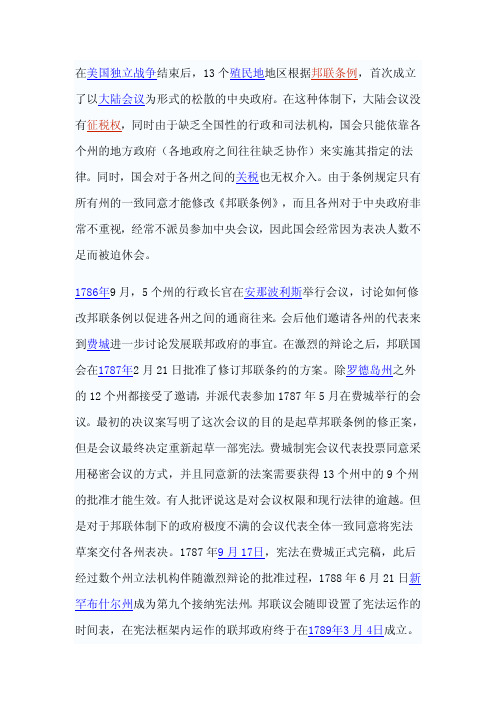
其中译文如下:
我们合众国人民,为建立更完善的联邦,树立正义,保障国内安宁, 提供共同防务,促进公共福利,并使我们自己和后代得享自由的幸福, 特为美利坚合众国制定本宪法。
这篇序言并没有赋予或者限制任何主体的权力,仅仅阐明了制定美国 宪法的理论基础和目的。尽管如此,这篇序言尤其是最开头的“我们 合众国人民”(英文为"We the people"三个单词)却成为美国宪法 中被引用频率最高的部分。
12 1804 年6 月 15 总统选举办法
日
13
1865 年12 月 6 日
废除奴隶制度
14
1868 年7 月 9 日 国籍护权
15
1870 年2 月 3 日 所有公民不得由於肤色和种族的区别而受到选举权的限制。 (不包括性别)
16 1913 年2 月 3 日 国会对所得税的征收权
7
1791 年12 月 15 日
民事案件接受陪审团审判的权利
8
1791 年12 月 15 日
禁止过度严厉的刑罚和罚款
9
1791 年12 月 15 日
宪法未列明的权利同样受保护
10
1791 年12 月 15 日
宪法未赋予政府的权利都属于各州和人民
11 1795 年2 月 7 日 限制联邦法院对各州的管辖权
[编辑] 宪法批准程序
主条目:美国宪法第七章
宪法第七章规定了这部宪法本身得以生效的表决程序。起初美国宪法 作为邦联条例的修正形式,需要获得全部 13 个州的批准方能成立。 然而宪法第七章只要求获得 9 个州以上的批准就可以使宪法生效。为 此,许多学者认为一旦只有 9 个州批准了这部宪法草案,那么将从原 有的邦联中脱离出来,成立一个新的联邦体国家。而不批准的其余州 将留在旧邦联体制内。事实上,这种理论并没有得到实践的印证,因 为 13 个州最终全部批准了这部宪法。
- 1、下载文档前请自行甄别文档内容的完整性,平台不提供额外的编辑、内容补充、找答案等附加服务。
- 2、"仅部分预览"的文档,不可在线预览部分如存在完整性等问题,可反馈申请退款(可完整预览的文档不适用该条件!)。
- 3、如文档侵犯您的权益,请联系客服反馈,我们会尽快为您处理(人工客服工作时间:9:00-18:30)。
The United States Bill of Rights. The Ten Original Amendments to the Constitution of the United States
Passed by Congress September 25, 1789
Ratified December 15, 1791
“The United States Bill of Rights” is a publication of The Pennsylvania State University’s Electronic
Classic’s Series, Jim Manis, Senior Faculty Editor.
The Pennsylvania State University is an equal opportunity University.
This publication of “The United States Bill of Rights” is a publication of the Pennsylvania State University. This Portable Document file is furnished free and without any charge of any kind. Any person using this document file, for any purpose, and in any way does so at his or her own risk. Neither the Pennsylvania State University nor Jim Manis, Faculty Editor, nor anyone associated with the Pennsylvania State University assumes any responsibility for the material contained within the document or for the file as an electronic transmission, in any way.
“The United States Bill of Rights” the Pennsylvania State University, Jim Manis, Faculty Editor, Hazleton, PA 18201-1291 is a Portable Document File produced as part of an ongoing student publication project to bring classical works of literature, in English, to free and easy access of those wishing to make use of them.
Copyright © 1998 The Pennsylvania State University
The Pennsylvania State University is an equal opportunity University.
I Congress shall make no law respecting an establishment of religion, or prohibiting the free exercise thereof; or abridging the free-dom of speech, or of the press, or the right of the people peaceably to assemble, and to pe-tition the Government for a redress of griev-ances.
II A well-regulated militia, being necessary to the security of a free State, the right of the people to keep and bear arms, shall not be infringed.
III No soldier shall, in time of peace be quar-tered in any house, without the consent of the owner, nor in time of war, but in a manner to be prescribed by law.
IV The right of the people to be secure in their persons, houses, papers,and effects, against unreasonable searches and seizures, shall not be violated, and no Warrants shall
The United States Bill of Rights.
The Ten Original Amendments to the Constitution of the United States Passed by Congress September 25, 1789
Ratified December 15, 1791
issue, but upon probble cause, supported by oath or affirmation, and particularly describ-ing the place to be searched, and the persons or things to be seized.
V No person shall be held to answer for a capital, or otherwise infamous crime, unless on a presentment or indictment of a Grand Jury, except in cases arising in the land or naval forces, or in the Militia, when in actual service in time of War or public danger; nor shall any person be subject for the same of-fense to be twice put in jeopardy of life or limb; nor shall be compelled in any criminal case to be a witness against himself, nor be deprived of life, liberty, or property, without due process of law; nor shall private property be taken for public use without just compen-sation.VI In all criminal prosecutions, the accused shall enjoy the right to a speedy and public trial, by an impartial jury of the State and district wherein the crime shall have been com-mitted, which district shall have been previ-ously ascertained by law, and to be informed of the nature and cause of the accusation; to be confronted with the witnesses against him; to have compulsory process for obtaining wit-nesses in his favor, and to have the assistance of counsel for his defense.
VII In suits at common law, where the value in controversy shall exceed twenty dollars, the right of trial by jury shall be preserved, and no fact tried by a jury shall be otherwise re-examined in any court of the United States, than according to the rules of the common law.
The Bill of Rights
VIII Excessive bail shall not be required nor excessive fines imposed, nor cruel and un-usual punishments inflicted.
IX The enumeration in the Constitution, of certain rights, shall not be construed to deny or disparage others retained by the people. X The powers not delegated to the United States by the Constitution, nor prohibited by it to the States, are reserved to the States re-spectively, or to the people.
The Bill of Rights。
